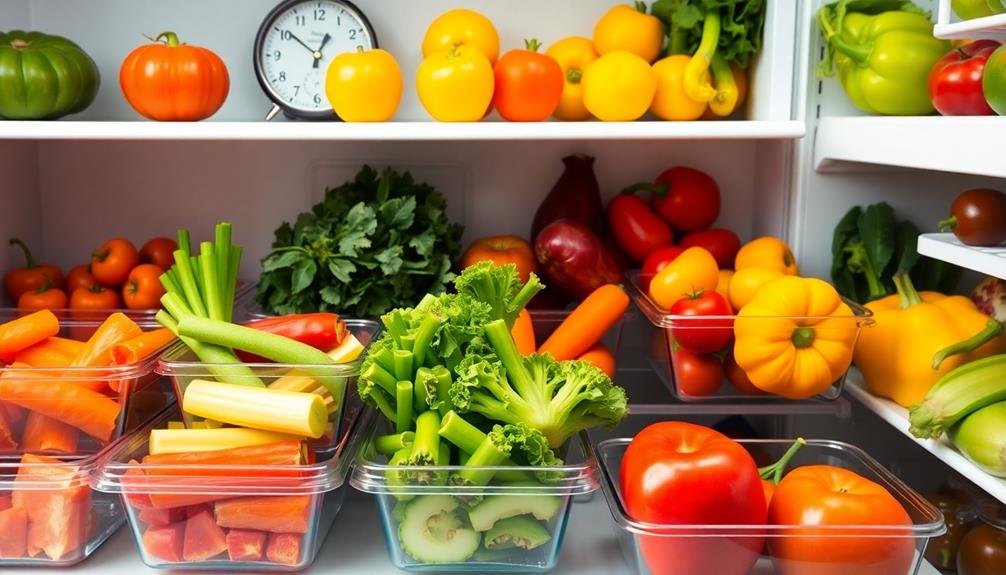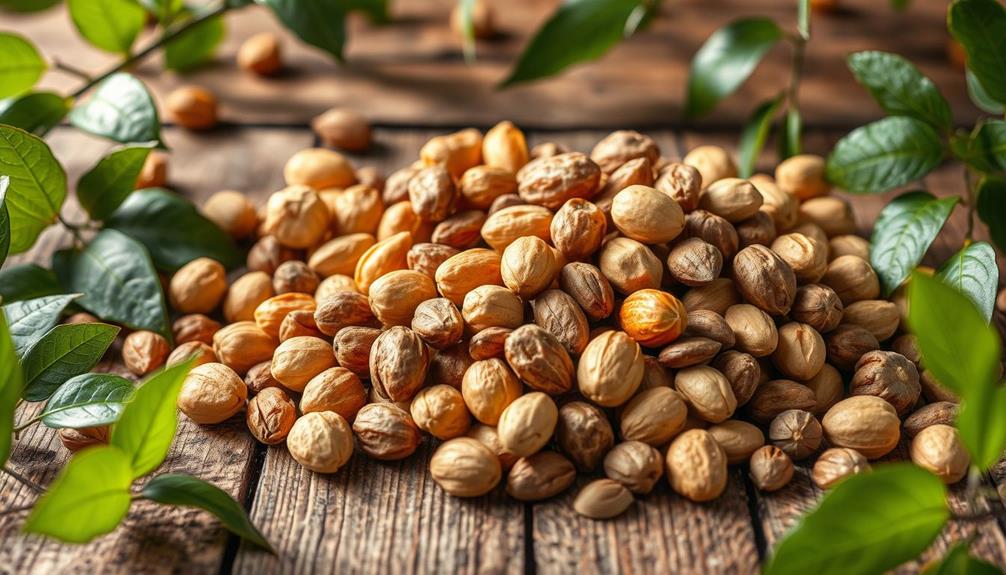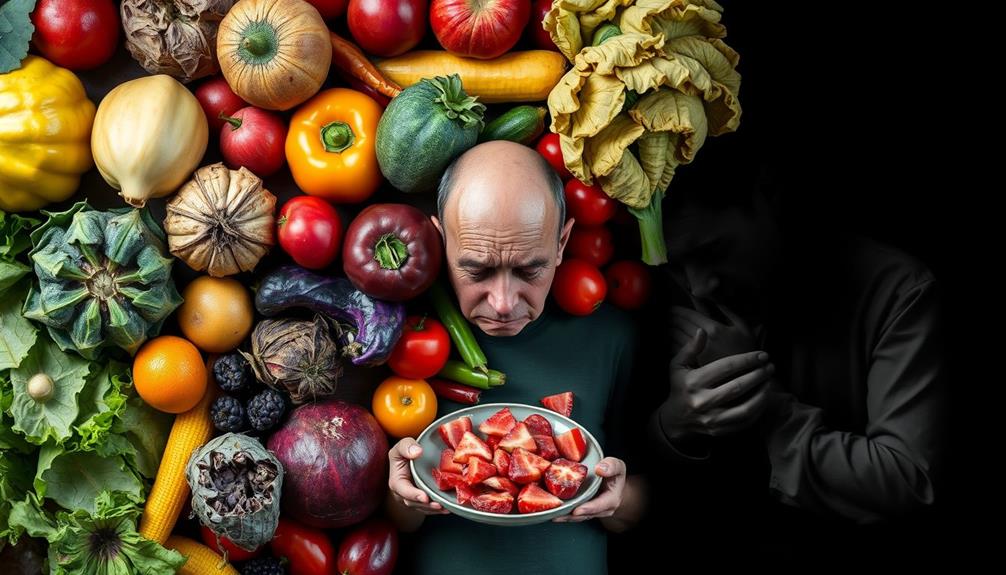Yes, a raw food diet can cause bloating, mainly due to its high fiber content and certain foods that are hard to digest. When you suddenly increase fiber intake, your gut may struggle to adapt, leading to gas and discomfort. Foods like broccoli and apples, which are high in FODMAPs, can ferment in your gut and worsen bloating. To minimize these effects, gradually introduce high-fiber foods, focus on proper food combinations, and make certain you're hydrated. Knowing how to balance your raw food choices can greatly improve your comfort and digestion. You might find more helpful tips if you explore further.
Key Takeaways
- Raw food diets often lead to bloating due to high fiber content that requires time for the gut to adapt.
- Certain raw foods, especially high-FODMAP items like apples and broccoli, can ferment in the gut and produce gas.
- Gradually introducing high-fiber raw foods can minimize bloating and digestive discomfort.
- Cooking or peeling raw vegetables and fruits can help reduce bloating by breaking down indigestible fibers and sugars.
- Staying well-hydrated and practicing proper food combinations can enhance digestion and reduce bloating risks.
Understanding Raw Food Bloating
Bloating can be a frustrating side effect of adopting a raw food diet. When you switch to raw foods, the high fiber content can overwhelm your digestive system, especially if you're coming from a lower-fiber diet. Your gut bacteria need time to adapt to this sudden increase in fiber, leading to initial gas and bloating as fermentation occurs in your intestines.
Additionally, certain raw foods can be rich in cold medications that might affect your digestive health. Many raw foods are rich in FODMAPs, which are non-digestible fibers that can ferment and cause gas. If you consume high FODMAP foods in excess, you might experience even more bloating.
While digestive enzymes found in some raw foods, like bromelain in pineapple, can help break down food, they may not be enough for everyone, leaving you with digestive discomfort.
To manage bloating, aim for a balanced mix of raw fruits, vegetables, and healthy fats. Timing your meals properly can also make a significant difference. By being mindful of these factors, you can help mitigate bloating and enhance your overall health while enjoying the benefits of a raw food diet.
The Role of Fiber

Fiber plays an essential role in your digestive health, especially when you switch to a raw food diet. Raw foods are typically high in dietary fiber, which can enhance your digestion but might also lead to bloating if you're not used to it.
When you begin this shift, your gut microbiome needs time to adapt to the increased fiber levels, which can initially result in bloating. Additionally, consuming foods rich in antioxidants, such as fruits and vegetables, can support overall health, but it's vital to be mindful of how your body responds to this dietary shift rich in antioxidants.
Soluble fiber found in raw foods absorbs water and swells in your gut. If you consume it in large amounts or don't introduce it gradually, it can potentially cause gas and bloating.
High-fiber raw foods, like fruits, vegetables, nuts, and seeds, can ferment in your intestines, leading to gas production.
However, don't be discouraged. Consistent consumption of these high-fiber foods will improve your gut health over time. As your body adjusts, it becomes more efficient at digesting fiber, which can ultimately reduce bloating.
Embracing this change may require patience, but the long-term benefits for your digestive health are worth it. With time, you'll likely find that your body thrives on the fiber-rich goodness of raw foods.
Common Raw Foods That Cause Bloating

When you're enjoying a raw food diet, it's important to be mindful of certain high-fiber vegetables and fructose-rich fruits. Foods like broccoli, cauliflower, apples, and pears can cause bloating if consumed in large amounts.
Additionally, understanding how different foods affect your digestion can help you make informed choices, especially when considering the effects of caffeine in coffee and its preparation methods on your overall wellness various brewing methods.
Understanding how these foods affect your digestion can help you make better choices for your gut health.
High-Fiber Raw Vegetables
Many people enjoy incorporating high-fiber raw vegetables into their diets for their health benefits, but these foods can sometimes lead to uncomfortable bloating. High-fiber raw vegetables like broccoli, cauliflower, and Brussels sprouts contain indigestible sugars such as raffinose, which can create gas during digestion.
Additionally, effective strategies for weight loss emphasize the importance of a balanced diet, which can help mitigate digestive discomfort. If you're not used to a high-fiber diet, this can result in significant discomfort.
The fiber content in these raw vegetables can overwhelm your digestive system, especially if you consume large quantities in one sitting. This is why it's important to gradually incorporate them into your meals. By doing so, your gut can adapt, minimizing bloating and improving overall digestive comfort.
Cooking raw vegetables is another effective way to alleviate bloating. Cooking helps break down the fibers and sugars, making them easier for your digestive system to process.
If you find that raw vegetables consistently cause gas and discomfort, consider steaming or roasting them instead. This simple adjustment can allow you to enjoy the benefits of high-fiber vegetables without the unpleasant side effects.
Fructose-Rich Raw Fruits
Incorporating raw fruits into your diet can add variety and essential nutrients, but certain fructose-rich options may lead to bloating. Fruits like apples and pears are high in fructose and contain hard-to-digest, high-fiber skins, which can cause gas and digestive issues for some people.
If you find yourself bloated after eating these fruits, peeling or cooking them might help ease symptoms. Additionally, being mindful of your overall budget for food can help you make healthier choices while reducing digestive discomfort.
For those with fructose malabsorption, consuming large quantities of fructose can overwhelm your digestive system, leading to discomfort and bloating. Other high-fructose fruits, such as watermelon and mango, can also contribute to bloating, especially when eaten in excess or on an empty stomach.
To enjoy the health benefits of fruits while reducing bloating, consider opting for lower fructose alternatives like bananas, berries, and oranges. These options can still provide essential nutrients without the risk of excess gas and digestive discomfort.
Food Combinations and Timing

Proper food combinations and timing are essential for preventing bloating, especially in a raw food diet. To optimize digestion, start by consuming fruits first, followed by greens, and then fats. This order helps your gastrointestinal tract process each food efficiently, reducing discomfort and bloating.
Fruits digest quickly, while fats take longer. Mixing them can lead to fermentation, which contributes to bloating. Incorporating gentle stretching before mealtime can also aid digestion, helping to alleviate any tension in the body and promote a more comfortable eating experience, similar to how yoga can help with back pain.
Meal timing also plays a significant role. Whole foods digest differently than cooked foods, so spacing your meals appropriately can minimize digestive issues. Aim for consistent eating intervals to help your body manage the increased fiber intake that often comes with a raw vegan diet.
This consistency supports your intestinal health and helps prevent bloating. While small amounts of fats, like flaxseed, can be included in smoothies, it's wise to save overt fats for later in the day. By being mindful of your food combinations and meal timing, you can create a more harmonious digestive experience, ultimately reducing the likelihood of bloating and discomfort.
Digestive Enzymes and Support

Achieving a balanced raw food diet often requires more than just mindful food combinations and timing; it also benefits from the inclusion of digestive enzymes. These enzymes, like bromelain found in pineapple, play a vital role in breaking down proteins and waste in your gastrointestinal (GI) tract, enhancing your overall gut health.
Additionally, certain essential oils, such as peppermint oil, can provide soothing relief for digestive discomfort. As you shift to a raw vegan diet, supplementing with high-quality digestive enzymes can make a significant difference in how your body processes fiber-rich foods.
Your digestive system, which is about 30 feet long, can struggle with increased fiber intake, leading to digestive problems and discomfort like bloating. Consistently incorporating digestive enzymes—either through whole foods or supplements—can help mitigate these issues. They assist in improving nutrient absorption, ensuring you get the most out of your meals.
As you adapt to a raw food lifestyle, these enzymes help your gut adjust to new dietary changes effectively. By supporting your digestive system with the right enzymes, you can reduce symptoms of discomfort and promote better gut health, making your raw vegan journey more enjoyable and sustainable.
High FODMAP Foods to Monitor

High FODMAP foods can considerably impact your digestive comfort, especially when following a raw food diet. These non-digestible fibers can ferment in your intestines, leading to gas and bloating, which is why it's crucial to be aware of your dietary choices.
For instance, certain fruits like apples and pears can trigger discomfort, while cruciferous vegetables, such as broccoli and cauliflower, are also known for causing bloating, so keep an eye on your intake. If you're concerned about your breast health, it's important to discuss dietary habits and symptoms with healthcare providers, as mammography aims to detect breast cancer early for better treatment outcomes.
If you're lactose intolerant, dairy products like milk and cheese can exacerbate your symptoms due to their high FODMAP content. Even if you're not lactose intolerant, these foods can still affect your digestion negatively.
Additionally, certain grains, particularly wheat and rye, are high in FODMAPs and may worsen bloating symptoms if you have gluten sensitivity.
Reducing the consumption of these high FODMAP foods can help alleviate bloating and improve your overall digestive comfort. If you notice discomfort during your raw food journey, consider adjusting your diet by cutting back on these problematic items.
Monitoring your intake can make a significant difference in how you feel day-to-day.
Transitioning to a Raw Diet

As you commence on the journey of shifting to a raw diet, you might experience some bloating due to a sudden surge in fiber intake. This increase can challenge your digestive system, causing temporary discomfort.
High-fiber raw foods like fruits and greens are great for health, but your gut bacteria need time to adjust to this new diet. Additionally, incorporating foods with beneficial properties, such as glycolic acid for skin benefits, can also aid in overall digestion.
Initially, your body may struggle to process the fiber effectively, which can delay the flushing out of impacted waste.
To ease the change and minimize bloating, consider the order in which you consume your foods. Start your day with fruits, as they digest quickly and can help your gut acclimate. Follow up with greens, and then include healthy fats later.
This approach allows for best digestion, reducing discomfort as your body learns to handle more raw foods.
Hydration and Digestion

Staying hydrated is essential for your digestive health, as it helps your body produce enzymes and keeps things moving smoothly through your gut.
Additionally, consuming a diet rich in raw foods can enhance nutrient absorption and support overall digestive function.
Aim for 2-3 liters of water daily, but pay attention to when you drink—avoiding fluids 30 minutes before and after meals can support better digestion.
Importance of Water Intake
Water plays an essential role in digestion and can considerably impact your overall gut health. Adequate water intake, around 2-3 liters per day, supports digestive health by aiding in nutrient absorption and facilitating waste elimination.
When you stay hydrated, you help reduce bloating symptoms and prevent gastrointestinal discomfort. Hydration is vital for maintaining enzyme production. Dehydration can impair digestion, making it harder for your body to break down food effectively.
Drinking warm liquids, like herbal teas, may enhance digestion further and provide relief for those experiencing bloating. Proper hydration also alleviates constipation, a common contributor to bloating, by promoting regular bowel movements.
When your body is well-hydrated, it functions more efficiently, making it easier to maintain a healthy digestive system. Incorporating sufficient water intake into your daily routine is essential for optimizing digestion and enhancing your digestive health.
Timing of Hydration
Hydration timing can greatly influence how well your body digests raw foods. To optimize your digestive health and minimize bloating, consider these key points:
- Drink fluids strategically to enhance nutrient absorption.
- Avoid drinking 30 minutes before and after meals to prevent dilution of stomach acid.
- Aim for a daily water intake of 2-3 liters to combat constipation, especially with high-fiber raw foods.
- Warm liquids, like herbal teas, can promote relaxation and support digestion.
- Monitor how different hydration timings affect your bloating symptoms.
When you stay properly hydrated, your body produces the enzymes needed for effective digestion, which is essential for breaking down raw foods.
However, drinking too much during meals can hinder digestion, leading to discomfort and bloating. By timing your hydration well, you not only support digestion but also improve nutrient absorption, ensuring your body gets the most out of your meals.
Tips to Reduce Bloating

Reducing bloating while enjoying a raw food diet can be achieved with a few simple strategies.
First, when you shift to a high-fiber diet, gradually increase your fiber intake. This allows your digestion to adapt, reducing the likelihood of bloating. To further help your body, soak or sprout legumes and grains before eating. This process breaks down phytic acid and indigestible sugars, making them easier to digest.
Stay hydrated by drinking plenty of water throughout the day. Proper hydration supports digestion and can greatly reduce bloating symptoms.
Additionally, practice mindful eating by chewing your food thoroughly and eating slowly. This prevents you from swallowing air and aids digestion, which can alleviate bloating.
Incorporate digestive enzymes from whole food sources, like pineapple, to assist your body in breaking down food. Including a variety of fruits and vegetables in your diet won't only enhance the nutritional value but also promote gut health.
Frequently Asked Questions
Why Am I so Bloated After Eating Raw Vegetables?
You might feel bloated after eating raw vegetables because they're high in fiber and complex sugars that can ferment in your gut. Your digestive system may need time to adjust to these changes.
What Is the Number One Food That Causes Bloating?
The number one food causing bloating for many people is legumes, like beans and lentils. Their high fiber and oligosaccharides can be tough to digest, leading to gas buildup in your digestive system.
Why Do You Bloat When You Start Eating Healthy?
When you start eating healthy, your body's adjusting to higher fiber levels. This sudden change can overwhelm your digestive system, leading to gas and bloating as it adapts to the new foods. Give it time!
What Does Raw Food Do to Your Stomach?
Think of your stomach as a garden; raw food can sow seeds of health. It boosts fiber intake, sparks digestion, and may initially stir discomfort as your body adjusts. You'll feel vibrant with time, though!
Conclusion
In your journey to embrace raw foods, remember that even the most vibrant garden can have its weeds. While bloating can be an unwelcome guest, it's often just your body adjusting to a new rhythm. By paying attention to fiber intake, food combinations, and hydration, you can cultivate a more comfortable experience. Stay mindful of your body's signals, and soon, you'll find that raw eating can be a rejuvenating and enjoyable part of your lifestyle.










